| Srl | Item |
| 1 |
ID:
190118
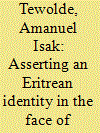

|
|
|
|
|
| Summary/Abstract |
Current literature on Eritrean national identity has been dominated by debates on its function as a unifying and homogenising civic identity in a context of a multi-ethnic, multi-religious and multi-clan national context. Little is known, however, about how an Eritrean national identity is mobilised among Eritreans living in racially organised host societies. This paper addresses this lacuna by examining how Eritrean refugees living in a racially classified South African host society self-identified. The focus of analysis for this paper was how an Eritrean national identity was mobilised by some participants in the face of experiencing racial classification. Some individuals defined themselves as ‘Eritrean’ to resist their classification as ‘Black’ in everyday life. I argue that beyond functioning as a homogenising and unifying civic identity, an Eritrean national identity functioned as a bulwark against ascribed racial classification in a race-conscious South African host society,
|
|
|
|
|
|
|
|
|
|
|
|
|
|
|
|
| 2 |
ID:
179013


|
|
|
|
|
| Summary/Abstract |
This paper is about self-identification by a sample of young people with various migrant backgrounds in Sweden. In a survey we asked them how they present themselves to others in different contexts (in their schools and neighbourhoods or when they are out of Sweden). Our findings suggest that young people’s identification is not fixed. The paths to these various forms of identification are shaped by a variety of individual (class background, parents’ country of origin) and social factors (friendship networks and school composition). The results indicate that those who identified themselves as Swedish or hyphenated tended to be quite similar as regards their other characteristics, while those who presented themselves with the parents’ birth country or religious affiliation have very little in common.
|
|
|
|
|
|
|
|
|
|
|
|
|
|
|
|
| 3 |
ID:
083285
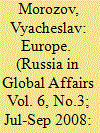

|
|
|
|
|
| Publication |
2008.
|
| Summary/Abstract |
The conflict between Russia and the European Union is much more profound than a mere collision of pragmatic, rationally formulated interests. The disagreement relates to the self-identification of both political subjects in time and space, which in turn has an inseparable link to ethic problems, to the understanding of good and evil, and to the perception of threats to security
|
|
|
|
|
|
|
|
|
|
|
|
|
|
|
|
| 4 |
ID:
073617
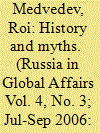

|
|
|
|
|
| Publication |
2006.
|
| Summary/Abstract |
Successful self-identification within the post-Soviet states often involves taking a new look at one's national history. Not all titular nations in the CIS had states of their own in the past, but all of them had a history on which to build their national self-consciousness.
|
|
|
|
|
|
|
|
|
|
|
|
|
|
|
|
| 5 |
ID:
106815
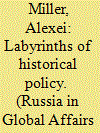

|
|
|
| 6 |
ID:
165073
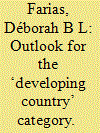

|
|
|
|
|
| Summary/Abstract |
In the 2016 edition of its World Development Indicators (WDI), the World Bank introduced an important change in the way it categorises countries: it explicitly stated the intention to eliminate the distinction of countries as ‘developing’ and ‘developed’. This decision represents the first time one of the world’s most powerful and influential international organisation has overtly decided to move away from this fuzzy-yet-ubiquitous terminology for categorising countries (and not proposing to replace the division). This paper takes this shift to discuss country groupings based on development levels, particularly the ‘developed’/’developing’ dichotomy, focusing on the latter term. The paper argues for a paradoxical scenario, wherein the label ‘developing’ will increasingly become analytically useless while concurrently retaining – or even strengthening – its power in the context of foreign policy strategies. The analysis details the motives behind this paradox and provides a reasoning for when and why the term’s usage is likely to be weakened or strengthened. Simply put, the ‘developed’/’developing’ dichotomy is weakening in its analytical capacity, mostly due to the increasing heterogeneity among countries under the ‘developing’ label and concurrent porosity of ‘boundaries’ between the two categories, while showing little sign of being phased as a term for self-identification.
|
|
|
|
|
|
|
|
|
|
|
|
|
|
|
|
| 7 |
ID:
186934
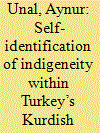

|
|
|
|
|
| Summary/Abstract |
Self-identification is a vital element in ethnic identity especially in the sense of indigenousness. This concept not only has been of concern for scholars, but also it is recognized as the most important definitive item in international law by such organizations as the UN, the World Bank and the ILO. This article focuses on self-identification of Kurdish ethnic identity by investigating how and to what extent indigeneity is expressed within the discourse on Kurdishness. Although the Kurds commonly are defined as an ethnic minority, the representatives of Turkey’s Kurdish political movement certainly refuse to be identified as such. The claim of pre-existence/indigenousness of the Kurds appears particularly in two levels that include the narrative of being an ‘autochthonous nation’ of Mesopotamia (‘kadim halk' in Turkish). Second, in reference to an agreement between Turks and Kurds during the First World War, Kurds are described as one of the ‘primary components [asli unsur in Turkish] of the Turkish Republic. To explore the concept of indigeneity based on self-identification within the discourse about Kurdishness, this article specifically examines how the Kurdish political movement in Turkey has a significant influence in regional politics and growing grassroots support.
|
|
|
|
|
|
|
|
|
|
|
|
|
|
|
|
| 8 |
ID:
177957
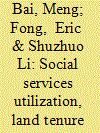

|
|
|
|
|
| Summary/Abstract |
This article explores whether the government policies are related to migrants taking on new self-identity. Drawing from the literature on identity, migrant adaptation, and citizenship, we propose a conceptual model of self-identity by rural migrants in China. We argue that self-identity of rural migrants is related to social policies that discourage a sojourner mentality and allow rural migrants to enjoy the same set of social benefits as local residents. Based on data collected in Xi’an in 2012, our findings support the argument. The findings have two important implications. First, our research shows that the simple dichotomy of rural versus urban in the literature regarding migrant workers in China may not be appropriate anymore, as a considerable proportion of migrant workers in China no longer identify themselves as rural residents and not urban residents. They identify themselves as “urban population from elsewhere” (chengshi wailai renkou). Second, our study opens a new venue for understanding self-identity of migrants. We offer an understanding of how social policies are related to self-identity.
|
|
|
|
|
|
|
|
|
|
|
|
|
|
|
|